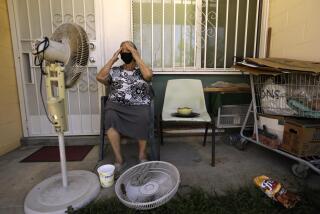Three Ways to Lessen Summer’s Heat and Glare
- Share via
QUESTION: I get a lot of heat and annoying glare through my windows and it fades the furniture. Is there any inexpensive method to block the sun (not in the winter), yet still have a clear view outdoors?
ANSWER: The sun’s intense heat through windows is a major contributing factor to high summertime electric bills. The ultraviolet (UV) light not only fades your furniture, but the UV-A rays actually break down the fibers.
Excessive glare is especially annoying when watching TV or using a computer. Often, you end up closing a shade or curtain and switching on a lamp. This wastes even more electricity.
There are three basic summer-only do-it-yourself methods to block the sun’s heat without totally blocking the view--static-cling window film, see-through pull-down shades and sun-control fiberglass and polyester screening.
All of these can be easily removed in the winter to take advantage of passive solar heating and reused again each summer. Another major advantage of these window treatments is more indoor privacy day and night.
Tinted vinyl static-cling window film is available in window-size kits or in bulk on rolls at home center stores. It is easy to install yourself. Some of the kits include a small utility knife and squeegee.
Static-cling window film sticks with static electricity to the indoor window surface. In the fall, peel it off and roll it up for next year. Vinyl film blocks about 80% to 90% of the sun’s fading UV rays.
These films are available in various shades of bronze and smoke (dark gray). Although all types look similar on the rolls or in the kits, there are differences in their heat and glare reduction properties.
Visible light transmission ranges from about 20% (greatest glare and heat reduction) to about 50% (lightest tint). Various manufacturers’ film thicknesses range from about 6 mils (thousandths of an inch) to 12 mils.
Roll-up see-through tinted window film shades (15 colors) are another option. These use multilayer polyester film with a special invisible heat-reflecting coating on the inner layers. These block more than 99% of the fading UV rays.
For smaller windows, a standard spring roll shade works well. For the most convenience, select motorized shades with hand-held remote controls or automatic sun sensors to open and close them.
Special heavy, close-weave window screening is a third option and allows for ventilation with sun control. Kits are available for easy installation.
Write for (or instant download www.dulley.com) Update Bulletin No. 460, a buyer’s guide of static cling window films (plus small sample piece) and solar-control shades and screens, sizes, specifications, prices and installation instructions. Please include $2 and a business-size self-addressed stamped envelope and mail to James Dulley, Los Angeles Times, 6906 Royalgreen Drive, Cincinnati, OH 45244.
Small Air Conditioner Should Be Cool Enough
Q: We have one room that does not stay cool enough in the afternoon. Does it make more economic sense to add a second zone to our central air conditioner ducts or to just add a room air conditioner?
A: If you have only one hot room, install a small high-efficiency room air conditioner. Using it will eliminate the need to set the central thermostat lower just to cool that one room adequately.
If you have several rooms that do not cool properly, usually in the same area of the house, consider adding a zoned cooling system with duct dampers.
Letters and questions to Dulley, a Cincinnati-based engineering consultant, may be sent to James Dulley, Los Angeles Times, 6906 Royalgreen Drive, Cincinnati, OH 45244; or instant download: www.dulley.com


